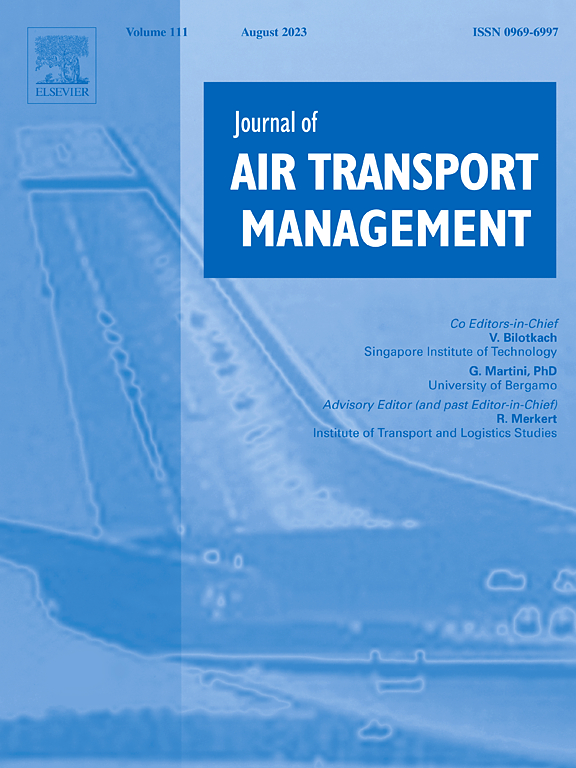Behavior study on pedestrian avoidance characteristics in aircraft cabin aisle
IF 3.6
2区 工程技术
Q2 TRANSPORTATION
引用次数: 0
Abstract
With the diversification of transportation, the emergencies encountered by travelers during travel are becoming increasingly complex. The narrow aisle space within aircraft cabins, due to layout limitations, significantly restricts evacuation behavior, thereby escalating the complexity of evacuation procedures. This work studies the impact of common emergency-limiting factors such as obstacle types, initial movement speeds, aisle widths, and movement modes on personnel avoidance behavior within aircraft cabins. Research has found that the presence of suitcase obstacle primarily influenced the choice of avoidance behavior through subjective factors such as movement mode and initial speed. Conversely, in scenarios with pedestrian obstacles, avoidance behavior is shaped by both subjective factors and the evacuation environment (aisle width, obstacle type). Regarding movement trajectory, the lateral movement range of pedestrians is mainly related to the width of the aisle. At the same time, the lateral deviation of pedestrian movement trajectory will be adjusted according to the movement mode and obstacle type, and the safe distance for pedestrians to avoid the obstacles is approximately 0.5 m–1.5 m. In addition, research has found that in a 0.4m wide and obstacle-free aisle, the need for "obstacle-free" evacuation has been met, and the speed no longer increases with the width of the aisle. The aisle width is the main factor affecting the distribution of the average movement speed range. When there is suitcase obstacle, the frequency distribution of pedestrians' movement speed is related to their movement mode. The low-speed frequency of the "individual" is significantly higher than that of the "group".
飞机客舱通道行人避扰特性行为研究
随着交通方式的多样化,旅行者在旅行中遇到的突发事件也越来越复杂。飞机客舱内狭窄的过道空间,由于布局的限制,极大地限制了疏散行为,从而增加了疏散程序的复杂性。本文研究了障碍物类型、初始运动速度、通道宽度和运动模式等常见紧急限制因素对飞机客舱内人员回避行为的影响。研究发现,行李箱障碍的存在主要通过运动方式和初始速度等主观因素影响回避行为的选择。相反,在有行人障碍物的情况下,回避行为受主观因素和疏散环境(通道宽度、障碍物类型)共同影响。在运动轨迹上,行人的横向运动范围主要与过道的宽度有关。同时,行人运动轨迹的横向偏差会根据运动方式和障碍物类型进行调整,行人避开障碍物的安全距离约为0.5 m - 1.5 m。此外,研究发现,在0.4m宽的无障碍通道中,已经满足了“无障碍”疏散的需要,并且速度不再随着通道宽度的增加而增加。通道宽度是影响平均移动速度范围分布的主要因素。当存在行李箱障碍物时,行人运动速度的频率分布与其运动方式有关。“个体”的低速频率显著高于“群体”。
本文章由计算机程序翻译,如有差异,请以英文原文为准。
求助全文
约1分钟内获得全文
求助全文
来源期刊

Journal of Air Transport Management
TRANSPORTATION-
CiteScore
12.40
自引率
11.70%
发文量
97
期刊介绍:
The Journal of Air Transport Management (JATM) sets out to address, through high quality research articles and authoritative commentary, the major economic, management and policy issues facing the air transport industry today. It offers practitioners and academics an international and dynamic forum for analysis and discussion of these issues, linking research and practice and stimulating interaction between the two. The refereed papers in the journal cover all the major sectors of the industry (airlines, airports, air traffic management) as well as related areas such as tourism management and logistics. Papers are blind reviewed, normally by two referees, chosen for their specialist knowledge. The journal provides independent, original and rigorous analysis in the areas of: • Policy, regulation and law • Strategy • Operations • Marketing • Economics and finance • Sustainability
 求助内容:
求助内容: 应助结果提醒方式:
应助结果提醒方式:


